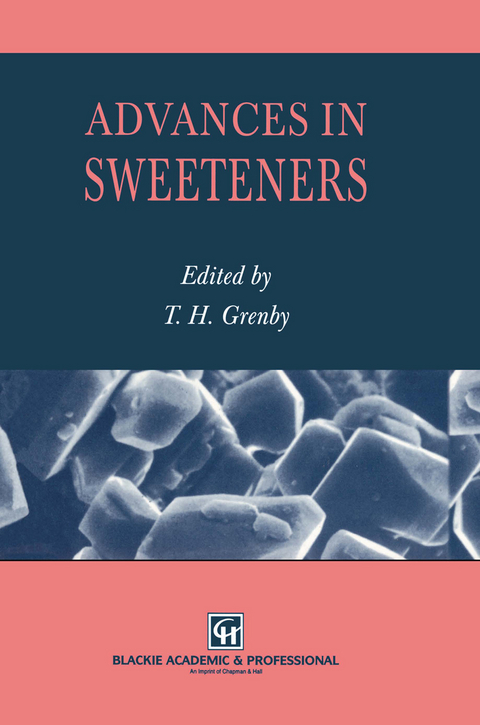
Advances in Sweeteners
Springer-Verlag New York Inc.
978-1-4612-8522-9 (ISBN)
1 Molecular structure and sweet taste.- 1.1 Introduction.- 1.2 Development of structure-taste theories.- 1.3 Classes of sweeteners.- References.- Further reading.- 2 Essential information on regulatory and legislative matters pertaining to sweeteners in the United Kingdom and the European Union.- 2.1 Current legislative position of sweeteners.- 2.2 The EU Sweeteners Directive.- 2.3 Implementation of the directive in United Kingdom law.- 2.4 Amendment of the Sweeteners Directive.- 2.5 Procedures for the addition of new sweeteners to the permitted list.- 2.6 Conclusions.- 3 Regulatory processes for new sweeteners in the United States of America.- 3.1 FDA’s responsibilities versus resources.- 3.2 Regulatory strategy for a food additive petition.- 3.3 Generating data for a food additive petition.- 3.4 Mechanics of a food additive petition.- 3.5 The petition review and approval process.- 3.6 Conclusion.- References.- 4 Physiological properties of polyols in comparison with easily metabolisable saccharides.- Summary.- 4.1 Introduction.- 4.2 Digestion.- 4.3 Absorption of polyols.- 4.4 Postprandial effects of polyols on blood glucose and polyol concentrations.- 4.5 Microbial utilisation of undigested and unabsorbed polyols in the colon.- 4.6 Gastrointestinal tolerance.- 4.7 Caloric utilisation of polyols.- 4.8 Dental health related aspects of polyols.- 4.9 Conclusions.- References.- 5 Versatility of maltitol in different forms as a sugar substitute.- 5.1 Introduction.- 5.2 Properties.- 5.3 Commercial forms of maltitol.- 5.4 Applications.- 5.5 Conclusion.- 6 Basic structure and metabolism of isomalt.- Summary.- 6.1 Introduction.- 6.2 Production of isomalt.- 6.3 General physico-chemical characteristics of isomalt.- 6.4 Metabolism of isomalt.- 6.5 Digestion and absorption ofisomalt.- 6.6 Isomalt: a bulk sweetener for diabetics.- 6.7 Energetic aspects: isomalt as a sweetener for calorie-reduced foods.- 6.8 Conclusions.- References.- 7 Properties and applications of isomalt and other bulk sweeteners.- 7.1 Introduction.- 7.2 Manufacturing processes of mono- and disaccharide alcohols.- 7.3 Safety aspects.- 7.4 Overview of bulk sweeteners.- 7.5 Sensorial properties.- 7.6 Market acceptance.- References.- 8 Nutritional properties and applications of erythritol: a unique combination?.- 8.1 Introduction.- 8.2 Chemical and physical properties.- 8.3 Erythritol, a naturally occurring substance.- 8.4 An entirely biotechnological process.- 8.5 Nutritional properties.- 8.6 Functional properties of erythritol.- 8.7 Food a pplications of erythritol.- 8.8 Conclusions.- Reference.- 9 Sweet taste and solution properties of ?,?-trehalose as a new cryoprotectant sugar.- 9.1 Introduction.- 9.2 Carbohydrates as cryoprotectants.- 9.3 Mechanism of cryoprotection.- 9.4 Physico-chemical properties of ?,?-trehalose in aqueous solution.- 9.5 Interpretation of interactions of ?,?-trehalose with water.- 9.6 Intensity/time relationships of ?,?-trehalose: relation of its physico-chemical properties to its sweet taste.- 9.7 Protective effect of ?,?-trehalose in freeze-dried fruit purées.- 9.8 Conclusion.- Acknowledgement.- References.- 10 Intense sweeteners and calorie control: the weight of a body of evidence.- 10.1 Introduction.- 10.2 The original observations.- 10.3 Recent studies on the effects of intense sweeteners.- 10.4 Conclusions.- References.- 11 Features of alitame™ as a new high intensity sweetener.- 11.1 Introduction.- 11.2 Development rationale.- 11.3 Physical and chemical characteristics.- 11.4 Temporal profile — sweetness quality.- 11.5Synergism — admixture potential.- 11.6 Utility in food systems.- 11.7 Decomposition pathways.- 11.8 Metabolism.- 11.9 Safety.- 11.10 Regulatory status.- References.- 12 Neohesperidine dihydrochalcone: recent findings and technical advances.- 12.1 Introduction.- 12.1 Origin, production and related substances.- 12.3 Regulatory developments.- 12.4 Stability.- 12.5 Sensory properties.- 12.6 Product applications.- References.- 13 The uses and commercial development of sucralose.- 13.1 Introduction.- 13.2 Production.- 13.3 Regulatory situation.- 13.4 Conclusions.- References.- 14 The blending of sweeteners — Applications and safety issues.- 14.1 Introduction.- 14.2 Synergism.- 14.3 Sweetness stability.- 14.4 Selection criteria.- 14.5 Safety.- 14.6 Intake considerations.- References.- 15 Cultural and legislative influences on the consumption of high intensity sweeteners in Europe.- 15.1 Objectives.- 15.2 Scope.- 15.3 Background.- 15.4 Legislation.- 15.5 Soft drinks.- 15.6 Formulations.- 15.7 Conclusions.- References.
| Zusatzinfo | XVI, 288 p. |
|---|---|
| Verlagsort | New York, NY |
| Sprache | englisch |
| Maße | 155 x 235 mm |
| Themenwelt | Technik ► Lebensmitteltechnologie |
| ISBN-10 | 1-4612-8522-4 / 1461285224 |
| ISBN-13 | 978-1-4612-8522-9 / 9781461285229 |
| Zustand | Neuware |
| Haben Sie eine Frage zum Produkt? |
aus dem Bereich


